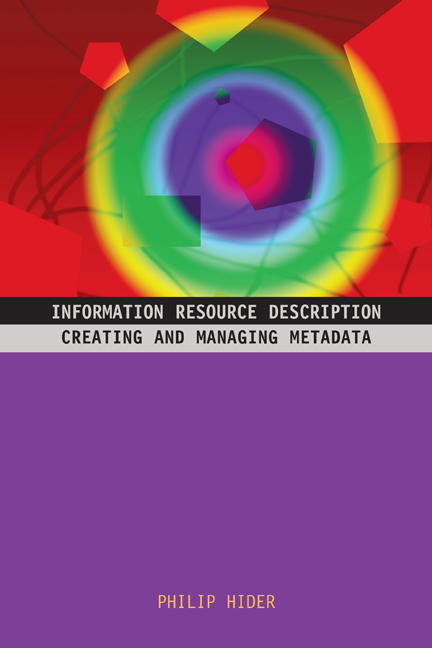Book contents
- Frontmatter
- Dedication
- Contents
- List of figures and tables
- Preface
- Abbreviations
- 1 Definitions and scope
- 2 Information resource attributes
- 3 Tools and systems
- 4 Metadata sources
- 5 Metadata quality
- 6 Sharing metadata
- 7 Metadata standards
- 8 Vocabularies
- 9 The future of metadata
- Further reading
- Metatadata standards
- Index
- Frontmatter
- Dedication
- Contents
- List of figures and tables
- Preface
- Abbreviations
- 1 Definitions and scope
- 2 Information resource attributes
- 3 Tools and systems
- 4 Metadata sources
- 5 Metadata quality
- 6 Sharing metadata
- 7 Metadata standards
- 8 Vocabularies
- 9 The future of metadata
- Further reading
- Metatadata standards
- Index
Summary
Introduction
In the previous chapter we talked about how the various attributes of information resources might be of interest to users, and are thus described as metadata for use in information retrieval systems. These systems bring together metadata for multiple resources and help the user to negotiate the information universe and gain access to what they need. While some information retrieval systems are based on the content of information resources, this chapter looks at those based on metadata, and which are central to the field of information organization.
In Chapter 1 we noted the three basic ways in which information resources can be organized in order to improve (effective) access to them: they can be arranged, labelled and indexed. These operations are by no means mutually exclusive, and many information retrieval systems make use of all three techniques. However, we shall begin by considering those systems that do not involve any form of index, and that are based solely on the arrangement and labelling of the items themselves.
Arrangements
Things have been arranged by people for many thousands of years, and information resources have been arranged for as long as there have been collections of them. For our purposes, arrangements are designed to help people look for information resources and look through information resource collections. Just as information resources have countless attributes that can be recorded in any number of ways, so too are there all sorts of ways to arrange them. Critically, users need to know in which way resources have been arranged.
Most sophisticated arrangements of information resources make use of labels. Both groups of resources and individual items can be labelled. In a library, there might be a ‘fiction’ section, a ‘sport’ section and so on. For more precision, however, each resource will have a label that indicates its place within the relevant section. This could be a ready-made label, such as an author's name on the spine of a book, or one assigned by the arranger, such as a library call number. In the online environment, labels are used on hyperlinks to describe (briefly) the target resource; together, these labels may be arranged to form, for example, a menu for a website or an online directory.
- Type
- Chapter
- Information
- Information Resource DescriptionCreating and managing metadata, pp. 33 - 58Publisher: FacetPrint publication year: 2012



